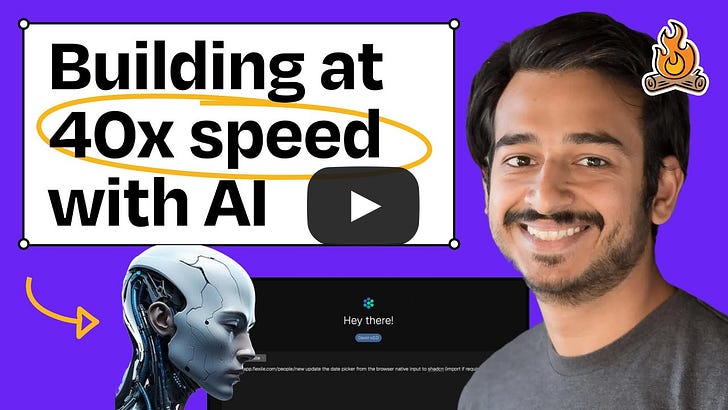🧠 Community Wisdom: How to encourage engineers to use AI more, best sales CRMs for early-stage startups, knowing …
👋 Hello and welcome to this week’s edition of ✨ Community Wisdom ✨ a subscriber-only email, delivered every Saturday, highlighting the most helpful conversations in our members-only Slack community. A big thank-you to this month’s community sponsor, Merge! Merge makes integrating with your customers’ software vendors easy. Add hundreds of integrations to your B2B SaaS products, with unified APIs for file storage, ticketing, CRM, ATS, HRIS, and accounting. AI companies love Merge because it delivers instant, secure access to clean customer data that powers their solutions. Stop wasting countless engineering hours staying ahead of breaking API changes and digging through a backlog of integration support tickets. Merge handles the full integration lifecycle so you can focus on what matters most: building your core product! ✨ Upcoming community meetups ✨Upcoming community-organized meetups—click the city name to RSVP:
Can’t find your city and want to host one? Just DM @Riya in our Slack. It takes 10 minutes (i.e. pick a date and location), and you get to meet awesome people from our community. Learn more here. 🎙️ New podcast episodes this weekBuilding a magical AI code editor used by over 1 million developers in four months: The untold story of Windsurf | Varun Mohan (co-founder and CEO): YouTube // Apple // Spotify  Gumroad CEO’s playbook to 40x his team’s productivity with v0, Cursor, and Devin | Sahil Lavingia: YouTube // Spotify // Apple  💥 Top threads this week1. Encouraging engineers to use AI more
Steve W: We faced this in our organization. We ultimately signed up for team accounts on both Cursor and Windsurf and said, this isn’t optional, choose which one you would like. The ones who were hesitant with Cursor actually adopted and love Windsurf. It’s kinda a pain managing two separate tools, but my team really likes the options. Rachel Hechter: We had a little bit of this in our org, where the engineers felt pressured to adopt these tools, but since the “mandate” wasn’t coming from them, it didn’t go very well. Why are they hesitant? Noah Tutak: I think that is part of it, some is just resistance to change. Steve W: Yeah, I agree with @Rachel Hechter. We have an awesome team lead, but he was one of the ones dragging his feet on Cursor. These are some of the things that got us over the hill:
Those things were enough to get him to use it. Now he is on board and pushing it for the rest of our team. Rachel Hechter: One thing we did that led to some good outcomes was to host an “AI exploration session” between product and dev, where each person was asked to share something AI-related for 10-15 minutes as a “show and tell.” It could be something fun or something that might actually apply to their work. This was actually what ended up spurring the devs to adopt Cursor across the team. It was also just really fun. There’s so much out there that it was cool for everyone just to see some different tools and play around a little with no real “outcome” other than exploration. Nicolay Gerold: As a quick prelude: I run an AI agency, I have worked on LLMs since 2019, and was among the first 1,000 devs using Cursor. I think making Cursor the default editor for engineers isn’t the right choice. Usually an engineer uses a single editor and he is really sensitive to it. Most good engineers optimize the shit out of it. Now that Windsurf, Copilot, Cursor are converging to feature parity, I am not sure whether I would push any of those. With the money moving into the space, nearly every code editor will have plugins or native AI integrations. Also, we have to think about the different types of tasks. Only a minority of my day is writing code. A lot of it is reviewing code, even more deciding how to solve a problem or figuring out how to integrate a new solution into the existing tech stack. All of these are tasks where AI does not excel. AI sucks at anything that crosses the boundaries in terms of tech stack. Then you have to consider your company codebase. Cursor and Windsurf often create more friction than value when you work with large, monolithic codebases, legacy systems, or newer libraries. I use Neovim and Cursor as my daily drivers, but I am increasingly unhappy with the “agent mode” that is being pushed. It is not considering best practices, it introduces a lot of bugs/uses the wrong libraries, it is taking much longer because it always takes at least 5 steps, and, down the road, I will need longer to debug issues, because I do not know the code as well as if I had written it from scratch. So at the moment I am mostly using Claude Code/Codex and Neovim. And I get way more done than in Cursor. Writing code has never been the bottleneck; the real challenge is understanding what to solve, how to solve it, and how to integrate the solution. I am not sure whether Cursor will do that for every engineer. If you have an engineer who is productive in Emacs, let him be in Emacs. You should encourage them to use the new tools, but in a way that allows them the muscle memory and experience they have built up in their coding environment. Adam Rice: As a very senior software engineer with a quarter century of experience, my honest opinion is these tools aren’t ready and produce trash code. If you’re only building a throwaway project/prototype, they’re probably very good. On something you hope to exist for many years, you should seriously consider the potential that you’re gaining results now at the expense of being completely blocked by tech debt in the future. In one case, I thought I’d see if Cursor could help me fix a small edge case in a 10-line method. It turned it into a 170-line method. Sure, the code worked (after maybe 6 revisions), but there was no way we could maintain that code into the future. If you are getting pushback from senior staff, I suspect it’s because they know that this tradeoff leads to future disaster and they don’t want to have to clean up the mess of short-term thinking. I use GitHub Copilot, but only for code completion. It now has similar features to Cursor and Windsurf, but it can’t fix the underlying models. Just code completion is a huge productivity win, and there is a free version now. Adam Rice: I run a meetup, and tonight someone was telling us about how they love Windsurf. In the same discussion, however, they also told a story of someone losing all their Docker containers by trusting the code. They demoed Windsurf and never managed to get the code to work; it was a maze of errors. If you want to get developers to use AI, you need to understand the resistance. If we just accidentally delete a production environment, that can be an all-nighter at best and a fireable offence at worst. If you’re not considering those implications, they’ll never follow you. 2. Best sales CRMs for early-stage startups
Evan Goldin: I’ve liked Front quite a lot. Great blended email and SMS support. Works seamlessly with Google Workspace. Pretty affordable, and I think they have special startup deals. Kaustubh Vongole: Thanks, Evan! Have you tried HubSpot at all? I’ve had experience with it at previous roles but am now finding it to be ... expensive. LX Cast: I keep hearing people say they like Clay, but I never got into it. You could, at this point, probably roll your own with Airtable, a template, and a few prompts Kaustubh Vongole: From what I’ve read, it seems like Clay is really meant to just hook up to your existing CRM? In terms of Airtable + templates, I probably can, but we’ve got so many things going on, I’d rather spend as little time as possible maintaining a CRM. Evan Goldin: @Kaustubh Vongole, are you trying to set up a sales CRM? Or support CRM? Very different needs, so would be good to clarify. Krishna AG: Started with Zoho—still with Zoho after 10 years. Kaustubh Vongole: @Evan Goldin, sales! Evan Goldin: Ah, sorry, I was thinking support. HubSpot is a great early sales CRM. Sophia O’Neal: Hi Kaustubh, I just did some research on this!
Let me know if you have any questions! I’ve set up quite a few for very early-stage startups. Carla: I can recommend HubSpot. Changing CRMs is a big job, so it’s best to start with the tool you can grow with. They also have very good service. They are happy to help you with anything and they have special start-up discounts. Tsvetan: Sheets haha. James Lewis: Nobody’s mentioned Attio yet. We use it—simple to get started but can be flexible and powerful! 3. Knowing your company’s exit strategy
Daniel Bartholomae: I don’t think that it is possible to get a good grasp on this without the information access that only management has. The best you can do is look at core financials: revenues, profit, and growth of these metrics. For a SaaS company, the rule of 40 is a good rule of thumb—but by far not enough information to get a good grasp on overall chances of an exit. Miroslav Pavelek: Moves like this often aren’t shared transparently—even within management—especially in uncertain environments. Krishna AG: Sharing it also is a very dangerous thing, since it can go either way ... the only scenario where they can share it is if they are planning on going public, and with that, too, only a timeframe. Surely no one can say, I will sell my startup to someone in 2-3 years—because the moment you try to “sell,” the value drops. Core metrics are crucial—like Daniel mentioned, if you have an independent path without any exit, that multiplies the chances of a good exit. David Jorjani: Why do you need to know? The only common reason I have seen over the years is if the IC wants to leave and decide on options. Beyond that, it’s not worth the mental energy to find answers. If that’s not your case, don’t expect or seek to know. If it is, you’ll need to make a bet with what you know. Joshua Herzig-Marx: Your CEO is signaling pretty hard that they don’t want to share! If there is some way to ask the question anonymously at an all-hands, you might consider that. Or you could ask your CEO directly in a non-confrontational (or private) way. You can, and should, also ask your manager. In terms of what I’ve seen: my experience is mostly very early-stage companies, and I’ve generally seen CEOs share their board decks (and have encouraged that). I’m very much on team transparency. Derrek: I recommend focusing on a different set of questions. What is the company’s strategy for growth? How ambitious are the goals? Does the strategy resonate with you as being a good strategy that will win and work? Is it clear how you can contribute? If these things are fuzzy to you and your colleagues even after you made a concerted effort to understand them and have conversations with leadership, then the hard truth might be that the company does not have a strategy. If they don’t, then the exit plans do not matter all that much. If they do have a clear strategy for growth, then focus on that and trust that in the future you’ll have an opportunity to benefit from it. Akos Tolnai: It’s always on a need-to-know basis. You can have an idea about the goals and metrics they would like to reach, but rarely the timeline if they do their job right. 4. Finding your first investors
Krishna AG: The networking, relationship building starts much earlier, with at least 3-5 reputed investors that are your first choice. The more the better; this needs one of two things—someone with a high reputation who can make intros (we had an industry expert as an advisor who VCs consulted with. Don’t entertain people who’ll make intros only; not as useful) or networking through startup events, friends in your circle who they’ve funded (this is very powerful), etc. Then, when you’re ready to pull the trigger, the groundwork that’s done before helps line up a lot of meetings in a relatively short time. Verdi: This is the key ^. If you start talking to investors when you want the money, you are already too late, from how the game is played. Ideally, connect early and build thin relationships ahead of time, so when you are in active fundraise 3-6 months later:
Krishna AG: As @Verdi touched upon, the adage goes: Ask for money, they give you advice. You ask for advice, they give you money. Gleb Curly: Investors are like seagulls. It is an all-pass or all-in game. If you’ve offered something interesting, you will be attacked from all sides. And they have their own network, so you just need to find the first who are serious. 🤓 Top finds
😂 Meme of the weekHave a fulfilling and productive week 🙏 If anyone in your life would benefit from this newsletter or community, consider giving them a gift subscription 💞 There are group discounts, gift options, and referral bonuses available. Sincerely, Kiyani 👋 Invite your friends and earn rewardsIf you enjoy Lenny's Newsletter, share it with your friends and earn rewards when they subscribe. |
Similar newsletters
There are other similar shared emails that you might be interested in:
- 🧠 Community Wisdom: Essential reading for early-stage founders, balancing unlimited SaaS plans with profitability…
- 🧠 Community Wisdom: Finding your voice on established teams, focus tips for ADHD brains, how to best use Granola,…
- 🧠 Community Wisdom: Designing great performance review templates, balancing oversight and autonomy with junior te…

